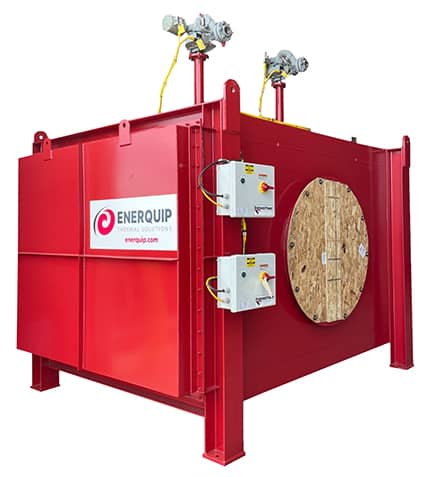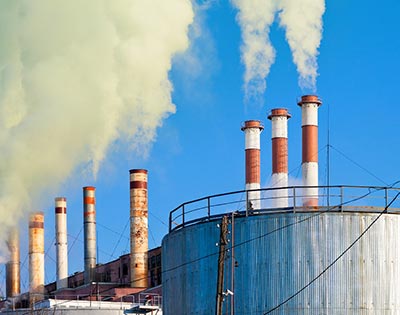If you are a plant or facility manager working in an industry that utilizes heat energy, chances are you have probably heard of waste heat recovery. If you don’t already have an industrial waste heat recovery system implemented in your facility, you may be wondering what waste heat recovery is, and whether or not it is appropriate for your organization.
Here, we’ll discuss it’s benefits, and the top reasons why you should utilize a waste heat recovery system in your facility if you are not doing so already.
What is Industrial Waste Heat Recovery?
Let’s start with the basics. Waste heat recovery is the practice of capturing hot gas exiting industrial equipment including incinerators, oxidizers, turbines, and gasifiers, and utilizing its energy for other industrial processes. Essentially, this process reuses heat energy that would otherwise be expelled and wasted.
Why is Heat Energy Recovery Important?

Industrial Waste Heat Economizer
Waste heat recovery systems are widely used throughout many industries – and for good reason. The process of recycling expelled heat and energy that would otherwise be wasted can have a surprisingly powerful impact, both on individual businesses and on industries as a whole.
There are numerous reasons why the recovery process is so important, including:
Increased Efficiency
As a society, we routinely recognize the importance of increasing efficiency. From installing high efficiency appliances in our homes to purchasing fuel-efficient cars, we are invested in making sure that our world operates as efficiently as possible on a day to day basis.
When it comes to increasing efficiency on a large scale, for instance in large manufacturing facilities and production plants, waste heat recovery systems are key. Installing these systems is a relatively small change that can have a profound impact on efficiency, both on an industry level and on a large scale.
Resource Conservation
It is a well known fact that our world has limited resources. In many cases, we are consuming resources faster than we can replenish them. As a result, ensuring that we are using resources efficiently and conserving them whenever possible should be a priority for any business – especially large scale businesses!
Reusing waste is one way that plants and facilities can help to conserve resources. In some cases, implementing a recovery system can eliminate the use of another heat source altogether. This can make a significant difference when it comes to conserving energy sources.
Waste Reduction
Plant heating and manufacturing processes inevitably result in the production of waste. While some waste is unavoidable, waste heat is one type of waste that can be repurposed instead of merely discarded.
Redirecting waste gas and utilizing it as a heat source can reduce the amount of waste produced by a facility and released into the atmosphere.
What are Waste Heat Recovery Units?
Industrial waste heat recovery systems come in a variety of styles and designs, but they all serve the same basic purpose. They capture the energy from hot exhaust and gases exiting industrial equipment like turbines and incinerators, then repurpose that energy to heat other materials and mediums, like oil and asphalt.
Essentially, they capture heat that would otherwise be wasted and enable a facility to use that heat and energy for other purposes and processes. They are ideal for use in a wide variety of applications and industries, and can positively impact your plant from an efficiency standpoint.
How Can An Energy Recovery Heat Exchanger Benefit Your Plant?
Implementing a waste heat recovery system can enable your facility to take advantage of all of the benefits listed above. It can also benefit your facility in the following ways:
It Can Reduce Your Plant Operating Costs
Plant and facility managers are consistently looking for ways to decrease their expenses and increase their profitability. Implementing a waste heat recovery system is a straightforward way to save money on your facility’s operating costs.
It Reduces Your Plant’s Energy Consumption
As mentioned previously, waste heat recovery technology has enabled companies of all kinds to reduce waste and increase efficiency. On a plant level, implementing a system like this can significantly reduce your plant’s energy consumption.
It Aids in Repurposing Dangerous Emissions
While waste heat recovery can help to conserve energy and reduce waste, it can also help to handle the dangerous waste generated from various processes. Some waste gases are dangerous and toxic. As a result they cannot be released directly into the atmosphere and must be incinerated first. Instead of disposing of these incinerated gases, a waste heat recovery system enables you to repurpose them in a way that can help to contribute to your facility’s productivity.
Interested in learning more about the benefits of waste heat economizers? Be sure to check out our waste heat recovery unit FAQs page for answers to common questions about waste heat economizers, an overview of their advantages, and more.
Invest in an Industrial Waste Heat Recovery System For Your Facility
Waste heat recovery is a strategy that can – and should – be implemented in any and all industries that utilize heat energy. From reducing waste and energy consumption to increasing efficiency and profitability, energy recovery systems are perhaps one of the most logical and practical investments a facility can make.
Interested in learning more about industrial waste heat recovery systems? With decades of experience in the industrial heating industry, we have the answers you are looking for. Give American Heating Company a call today at (715) 748-5888 or contact us online for more information.
Curious about the waste heat recovery systems we design and manufacture? Get the details about the waste heat recovery systems we offer here!
More from the Enerquip Blog
- Shell and Tube Heat Exchanger Design Options for Viscous Products
- How Tank Heating Coils Work
- How Annular Distributors Improve Efficiency in Shell and Tube Heat Exchangers
- 5 Reasons Why You Should Buy Your Complete Industrial Heating System in One Place
- Shell-Side Fluid Challenges: Increasing the Pressure Drop

